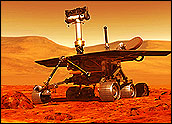
Scientific findings from the NASA rover Spirit’s first three months on Mars will be published Friday, marking the start of a flood of peer-reviewed discoveries in scientific journals from the continuing two-rover adventure.
Researchers using Spirit’s toolkit of geological instruments from early January into April read the record from rocks and soils in the rover’s landing area and found a history of volcanic blanketing, impact cratering, wind effects and possible past episodes of scant underground liquid water.
Evidence for the water comes from mineral alteration in the veins, inclusions and coatings of some rocks. Eleven reports with 120 collaborating authors from around the world lay out details in the August 6 issue of the journal Science.
“This is the first batch,” said Steve Squyres of Cornell University, principal investigator for the science payload on both Mars Exploration Rovers. “You’ll be seeing a lot more publications in months ahead and, no doubt, for many years to come based on information from Spirit and Opportunity. These machines just keep going and going, so the science just keeps coming and coming.”
Jim Garvin, NASA’s Chief Scientist for Mars added, “This is the basis for beginning the remarkable scientific legacy of the rovers that will not only rewrite our textbooks about Mars, but also pave the way for human exploration.”
Three-Month Primary Missions
The rovers completed three-month primary missions in April, then began bonus exploration in extended science missions. “Spirit and Opportunity have really done yeoman’s work, still operating after more than twice as long as their original assignments. We don’t know how much longer they’ll keep working, but while they do we promise to keep them busy,” said Jim Erickson, project manager at NASA’s Jet Propulsion Laboratory.
Both rovers were equipped and targeted to collect evidence about past environmental history, especially any history of liquid water, since life as we know it depends on water. Spirit is exploring inside Gusev Crater, an ancient Connecticut-sized impact basin that was selected as a landing site because it may have once held a giant lake fed by flows of water though a large valley that empties into the crater.
The new reports state that, in its first three months, Spirit found no evidence of lake-related (lacustrine) deposits. “Any lacustrine sediments that may exist at this location within Gusev apparently have been buried by lavas that have undergone subsequent impact disruption,” says the leadoff paper by Squyres and 49 other rover science team members. Spirit has subsequently driven to a different location — nearby hills over 3 kilometers (2 miles) away — to continue exploring.
Dust Particles and Magnetic Minerals
John Grant of the National Air and Space Museum reports that the rocks on the plain that Spirit explored during its primary mission increased about fivefold in maximum size as the rover got closer to an old 210-meter (690-foot-wide) impact crater.
The impact that excavated the crater brought volcanic rocks to the surface from as deep as 10 meters. Several papers give evidence that rocks in the area are a volcanic type called basalt and bear the mineral olivine. These include reports by Cornell’s Jim Bell with collaborators using Spirit’s panoramic camera and by Dick Morris of NASA Johnson Space Center, Houston, with collaborators using the Moessbauer spectrometer.
Ken Herkenhoff of the U.S. Geological Survey and other scientists using Spirit’s microscopic imager offer findings that rocks cut into by the rover’s rock abrasion tool have coatings and bright veins apparently from mineral alteration after the rocks formed.
Magnet experiments indicate almost all sampled dust particles in Mars’ atmosphere contain magnetic minerals, according to a paper by Preben Bertelsen of the Niels Bohr Institute. Ron Greeley of Arizona State University found that winds from the northwest grooved some rock surfaces and shaped sand ripples in the past. The way rock dust accumulates during grinding by Spirit’s rock abrasion tool shows that wind still comes from the same direction.

















































